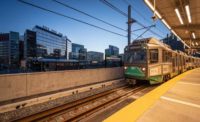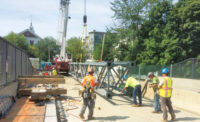Construction on the $2.3-billion Green Line extension is clanging toward its final destination after the opening of its first station in Somerville’s Union Square.
The opening of the Union Square branch earlier this month marked a significant milestone for the project, first proposed approximately three decades before construction started in 2018—after many starts and stops.
GLX Constructors is now focusing on the completion of the second and final branch of the mega project later this year—the 3.7-mile Medford branch that will run from the Lechmere Station in East Cambridge to the Tufts University campus.
The design-build project is led by GLX Constructors, a joint venture comprised of Fluor Enterprises Inc., The Middlesex Corp., Herzog Contracting Corp. and Balfour Beatty Infrastructure Inc., with STV Inc. as lead designer.
Stephen Varnell, a vice president with Fluor and a project manager with GLX Constructors, says there is a feeling of accomplishment with the end of the project in sight, especially given the challenges posed by the pandemic.
The project team was able to integrate social distancing and other preventative measures without stopping work.
In addition to laying new rail and systems, the joint venture built six new stations as part of the project, in addition to the relocated and revamped Lechmere Station in East Cambridge.
“The project has been on the books for thirty years,” Varnell says. “To have extended rail into these communities, some of which have never had rail service before, is a really big deal—and to do that working through the COVID pandemic makes the achievement that much more significant.”
GZA GeoEnvironmental Inc. provided geotechnical design for all permanent structures and designed permanent and temporary support of excavation retraining walls, while also providing instrumentation monitoring and quality control during foundation construction.
Robert Palermo, project principal at GZA, notes that the project was constructed in an existing rail corridor located in a dense urban environment with residential structures just a few feet from the new light rail construction. He says widening the existing right-of-way required constructing more than three and a half miles of retaining walls and reconstruction of four existing bridges and modification to two others.
“It was a really tight schedule and it required a lot of close coordination,” Palermo says. “It is a fascinating project and I am happy to look at it and say I was part of it.”
The design team also includes Arup, which is overseeing the design development, and testing and commissioning process. Arup originally served as an MBTA consultant in 2015 when the project ballooned $1 billion over budget. The design team helped the MBTA cut approximately $700 million from the project, including by designing less-elaborate stations. The MBTA’s revised program, unveiled in 2016, revived the project.
"The opening of this first segment of the Green Line extension is a testament to the incredible collective efforts and coordination," Jeff Tubbs, Arup principal and project director, said in a statement.
Behind the Scenes
While work on the track is complete, construction crews will be adding in many of the behind-the-scenes systems needed to operate the second and final branch on the new light rail line, including the electrical wiring to power trolleys, telecommunications systems and the security camera systems. John Dalton, the MBTA program manager for the GLX project, says the electrical installation work and subsequent testing is not “as flashy, but it’s a lot of details and it takes time.”
The rail systems can only be thoroughly tested after trains are placed on the tracks in the coming weeks. Additionally, while everything has been measured and remeasured, the final determination on whether the clearance space for the new cars meets fire and safety standards can only be fully tested with trains on the tracks.
For clarification: Railcars have not yet been introduced into the Branch 2 (Medford branch) testing program. Once they are introduced in the coming weeks, they can confirm they can open it for passenger service. Branch 1 (Union Square) is all open and running.
“It is not until you introduce the final variable of the train before you can have the confirmation that says all systems are behaving as they are supposed to,” Dalton says.
An array of local, state and federal elected leaders, T officials and executives from the joint venture, among others, marked the opening of Green Line service to Union Square with a ceremonial ribbon cutting on March 21.
The new Green Line extension is expected to draw 50,000 riders a day, helping to reduce congestion and air pollution on local highways and roads.
By the time the project is complete, the GLX project team will have laid down 100,000 railroad ties, 17 miles of track, nearly four miles of pilings, 22 million lb of steel girders, while also rolling out two miles of local pathways.
While most of the work is completed on the newly opened line, there remains a series of “punch list” items remaining on the project’s first phase, such as installing bus shelters and wiring the access control system for the bike storage system, the MBTA’s Dalton says
“Our objective was to get the trains into revenue service,” Dalton says.






Post a comment to this article
Report Abusive Comment